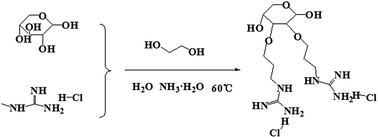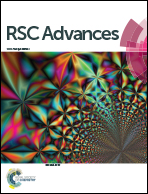A non-covalent strategy for montmorillonite/xylose self-healing hydrogels
Abstract
The self-healing capability of hydrogels has become a hot topic in the area of hydrogel research. An economical, convenient, eco-friendly, and reproducible approach for the preparation of self-healing xylose-based hydrogels is introduced in this article. First, methylguanidine hydrochloride was grafted onto the backbone of xylose using ethylene glycol as a crosslinking agent, then xylose with guanidinium ion pendants on its peripheries was entangled with exfoliated layered anionic montmorillonite (MMT) clay nanoplatelets under the dispersion of sodium polyacrylate (PAAS), thus forming xylose-based hydrogels, which were connected by hydrogen bonds and displayed intermolecular adsorption because of their internal spongy porous structure. The synthesized xylose-based hydrogels had a rapid self-healing ability and showed good swelling property. The structure and morphology of the composite hydrogels were characterized using FT-IR and SEM. The compression stress–strain results suggest that the elasticity of the xylose-based hydrogels increased with the increase of modified xylose solution, and the compression stress increased with the increasing concentration of modified xylose. Thermal gravimetric analysis (TGA) indicated that the composite hydrogels had a good heat resistant property due to the added inorganic MMT. All these properties demonstrate that the composite hydrogels have potential applications such as water absorbents, flame retardants, and as other functional materials.


 Please wait while we load your content...
Please wait while we load your content...